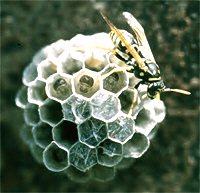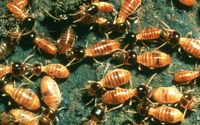Wasps, termites, and turkeys
 In 1719 a French scientist, Rene Antoine Ferchault de Reaumur, was taking a walk in the woods. Later he observed: "The American wasps make a very fine paper ... they extract the fiber of common wood and teach us that one can make paper from fibers of plants without using rags or linen."
In 1719 a French scientist, Rene Antoine Ferchault de Reaumur, was taking a walk in the woods. Later he observed: "The American wasps make a very fine paper ... they extract the fiber of common wood and teach us that one can make paper from fibers of plants without using rags or linen."The 18th century was in fact running out of rags and linen, the only known paper making materials.
 Still, it wasn't until 1850 that another scientist acted on Reaumur's observation: a German, Friedrich Keller, did find a way to make paper from wood, though the paper was not very good. In 1852 Hugh Burgess managed to duplicate wasps' digestion of cellulose using chemicals, and a series of improvements through the next twenty years ended in the paper we use today.
Still, it wasn't until 1850 that another scientist acted on Reaumur's observation: a German, Friedrich Keller, did find a way to make paper from wood, though the paper was not very good. In 1852 Hugh Burgess managed to duplicate wasps' digestion of cellulose using chemicals, and a series of improvements through the next twenty years ended in the paper we use today.Now, as Ira Flatow pointed out on Day to Day, a scientist has again turned to the bugs, this time to solve our energy problem.
Nobel laureate Steven Chu feels the seven billion dollars the US has put into ethanol subsidies has been wasted. First, there is the embarrassing arithmetic: creating ethanol uses more (fossil fuel) energy than can be extracted from the finished product. Second, because the process isn’t carbon-neutral, "from the point of view of the environment it would be better if we just burnt oil."
 Instead, Chu has been investigating the way termites digest wood into ethanol, a useable fuel. The termites' process does not contribute to global warming because a bacterial parasite in termite guts processes cellulose without releasing extra carbon.
Instead, Chu has been investigating the way termites digest wood into ethanol, a useable fuel. The termites' process does not contribute to global warming because a bacterial parasite in termite guts processes cellulose without releasing extra carbon. My first vision was of huge vats, teeming with termites snapping like eensy weensy piranhas at branches and rotten logs tossed to them by chortling lab techs. I bet a fair number of other things would get lobbed in there, too. Disappointingly, Chu is instead trying to discover a way to duplicate the process in a lab.
My first vision was of huge vats, teeming with termites snapping like eensy weensy piranhas at branches and rotten logs tossed to them by chortling lab techs. I bet a fair number of other things would get lobbed in there, too. Disappointingly, Chu is instead trying to discover a way to duplicate the process in a lab.This new flurry of news releases reminded me of my ecstatic reaction to an article in Discover Magazine in 2003 (I think) about a company that was turning turkey guts into diesel fuel. Then I never heard any more about it. Here is a link to the 2003 story in the National Geographic.
 So if you're still interested, here is a 2005 follow-up. Excerpts:
So if you're still interested, here is a 2005 follow-up. Excerpts:Changing World Technologies has developed a working system to convert turkey guts and scraps into fuel oil. But CWT's tribulations show how hard it is for even the most innovative green company to compete in the energy business
The company says its process works on tires, various hazardous wastes, and plastic as well as heavy metals.
The key question is whether the end products are pure enough and cheap enough to compete with other biofuels and petroleum. Until recently it seemed that turkey fuel would score big on both counts.
Expecting U.S. authorities to ban the feeding of animal offal to livestock—a practice linked to mad cow disease—CWT and ConAgra formed a joint venture that built a $30 million plant in Carthage, Mo. The venture assumed that nearby turkey processors would provide lots of free turkey waste.
It turns out that feeding animals to animals remains standard practice ... so instead of being free, turkey leftovers cost $30 to $40 a ton, a hefty expense considering that one ton of turkey yields just two barrels of oil.
And turkey fuel has so far been excluded from biofuel tax breaks. In October, Congress passed a bill that gave biodiesel, which is also derived from biological material, such as soybean oil and animal fat, but has a different chemical composition, a tax incentive that translates into a $1-a-gallon break on production costs.
As a result of those two setbacks, CWT's production costs have doubled ... CWT is staying afloat, thanks to a $10 million grant from the U.S. Department of Energy. But the company's next operation is likely to be in Europe, where food processors will pay to have CWT dispose of animal offal and where most governments offer tax incentives to biofuel producers.
Technorati Tags: Conservation, Environment, Fuel, Termite, Wasp, Turkey



 A few of my daughter
Melina's great posts:
A few of my daughter
Melina's great posts:








5 Comments:
Are you serious: one turkey yields 2 barrels of oil? I may never eat turkey again!
Uh-oh, sorry! Now you know I am not a good speed reader; I see it is one ton of turkeys, not just one. Mea Culpa!!
Thanks for posting that follow up. I remember reading that bio-fuel article as well.
useing bio fuel Tturkey parts or whatever sounds like a great idea to me. But as useual our govt. doesn't want to step on the profits of the oil companys so the process is headed to europe. i think more people should be made aware of this situation.
Neat site! Keep up the good work! Like the ideas in your site, including the one about the possibility of termites having the key to ethanol. Interesting that animals and bugs could teach us stuff. God locked away 'hidden secrets', even in creation for us to find. Think of George Washington Carver and the peanut. We just need faith to believe it's possible and go for it. Good work!
Post a Comment
<< Home